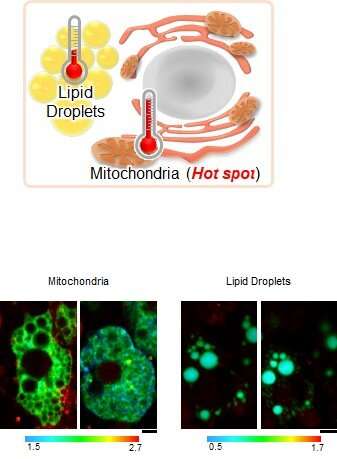Measuring the temperature inside cells

Organelles inside cells constantly serve specific functions in the same way that individual departments handle certain tasks in an organization. Cellular processes alter the amount of heat organelles generate, but it is not easy to monitor these changes in cells, which are too small to see with the naked eye. Recently, however, a joint research team from Korea and Japan has found a way to visualize temperature changes in almost all typical organelles.
Professor Young-Tae Chang of POSTECH's Department of Chemistry (associate director of the Center for Self-assembly and Complexity, Institute for Basic Science (IBS)) and Dr. Xiao Liu from IBS collaborated with professors Satoshi Arai and Takeru Yamazaki (Kanazawa University, Japan) to develop site-specific organelle fluorescent thermometers. The findings from the study were recently published in Materials Today Bio.
Detecting the intracellular temperature changes that are closely related to cellular processes can provide clues to understanding the complex function of organelles. However, investigating micro-temperature fluctuations in various organelles requires site-specific organelle thermometers. A previous version of the fluorescent thermometer worked only for one or two organelle types.
To overcome this limitation, the joint research team developed a new series of fluorescent thermometers (Thermo Greens, TGs) that visualize temperature variation in virtually all organelle types, including the cellular membrane, nucleus, Golgi apparatus, endoplasmic reticulum, mitochondria, lipid droplet, and lysosome. Furthermore, TGs displayed quantitative images of the heat generation at different organelles such as mitochondria or endoplasmic reticulum in brown adipocytes, which are essential for maintaining body temperature even in midwinter.
TGs are recognized as the first palette batch of small molecular fluorescent thermometers that can cover almost all typical organelles. These findings may prompt the development of new fluorescent thermometers and enhance future understanding of thermal biology. Also, these findings can be used to develop new fluorescent thermometers and promote a better understanding of thermal biology going forward.
More information: Xiao Liu et al, A palette of site-specific organelle fluorescent thermometers, Materials Today Bio (2022). DOI: 10.1016/j.mtbio.2022.100405
Provided by Pohang University of Science & Technology (POSTECH)


















